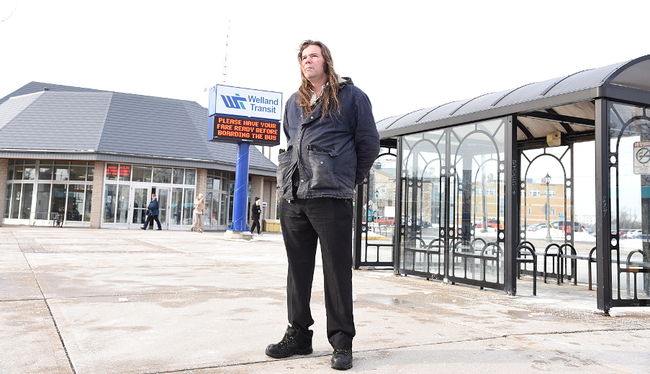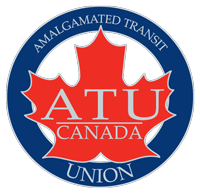
There was a time when he paid $160 a month for a bus that got him to work three hours too early.
And all he could do was resign himself to the fact that he was dependant on a bus schedule that wasn’t in synch with his life.
Not too long ago, Roderick Davidson, 44, lived in Welland and worked a night shift in Niagara Falls. Every night he’d catch the last Niagara Region Transit bus that left the terminal in downtown Welland, a short walk from his home.
The Route 65 bus pulled out at 8 p.m., and dropped him off at Niagara Square in the Falls, near his work, at 8:22 p.m. Problem was, he didn’t start work until 11:30 p.m. And that left him with three hours to kill before putting in an eight-hour shift.
“I’m glad they have the regional bus, but it’s just terrible hours,” he says.
He once missed it and couldn’t get to work. It needs to run later, for people who don’t work regular day jobs, he says.
“It’s an awful big chunk of money to spend for a service that got me to work three hours early,” he says.
A regional transit monthly pass is $160, a significant portion of his minimum-wage, $11.25-an-hour job.
Davidson also had to tell his employer that he couldn’t work weekends because there is no regional bus service on Sundays, or statutory holidays. In effect, he could get to work on a Saturday, but on Sunday he wouldn’t have a return ride home, or be able to get to work at night.
“You can stress out. But what’s the point in stressing out over something you can’t change,” he says.
“You just make the best out of a bad situation.”
He has since been transferred to Welland, where he walks to work.
Transit in Niagara is both inconvenient and costly for people who rely on it for the basics of life, says Rhonda Barron, who heads Niagara Poverty Reduction Network’s transportation working group.
The NPRN committee has joined forces with several other groups across the region including Niagara Sustainability Initiative, student unions at both Niagara College and Brock University, and a coalition of bus drivers and transit union reps, to explore solutions to a host of transit issues.
Anyone, like Davidson, who relies on riding a bus to work, often faces long trips due to infrequent buses (regional transit runs every hour), time spent waiting to transfer, and schedules that don’t reflect the realities of many jobs in Niagara that are not 9 to 5, she says.
Some examples:
Angela Browne is a paralegal with an office in downtown St. Catharines. Her family — Angela, her husband and high-school aged daughter — spend a total of $246 a month on St. Catharines transit passes. They do not own a car.
“One problem is we have a bus service that runs every hour a night,” she says. “People find it inconvenient, and as a result, transit says there’s less demand.”
Margaret Gilbert is a bus driver in Niagara Falls, and president of Amalgamated Transit Union Local 1582.
“Public transit needs to be more reliable for locals,” she says.
“They need to have a bus when they get off work late at night, or early in the morning.”
And their commute shouldn’t consume more time than absolutely necessary, she says.
Case in point: the decision to eliminate the regional transit bus route into the downtown Niagara Falls bus terminal. Currently, regional riders coming from St. Catharines need to transfer to a Niagara Falls city bus at the Target Plaza stop (Morrison Street and Dorchester Road), and face a less-direct route into the downtown. That change added another 45 minutes to their commute. So now, going from downtown St. Catharines to downtown Niagara Falls takes just shy of two hours, says Gilbert.
And forget about taking regional transit if you work at the Outlet Collection at Niagara mall in Niagara-on-the-Lake. The last bus leaves before the mall closes, she says.
Tikvah Mindorff is executive director of Niagara Sustainability Initiative in St. Catharines.
“People who make the decisions for transit should be people who use transit,” she says.
Before she bought a car, which she shares with her partner, she rode either a bike or the bus.
Transit must be attractive to everyone, even to people who can afford a vehicle, she says. But in Niagara, and St. Catharines specifically, transit is so inefficient, only people who have no other option use it.
“The minute you can afford a car you get one because transit is so bad,” she says.
“The 9-to-5ers don’t take it because it takes forever to get anywhere.
“Why would you spend 45 minutes going two kilometres when you can walk or drive it faster?”
In general, commuting within the downtown is good. But as soon as you need to travel anywhere else in St. Catharines, it becomes an exercise in transfers and longer-than-necessary commutes, she says.
Case in point: A few years ago, she lived near Carlton and Niagara streets and worked at a pub at MacTurnbull Drive and Vansickle Road. Her ride to work involved two buses and a 15-minute transfer delay at the downtown terminal (if the first bus arrived on time), and the entire trip lasted over 3/4 of an hour. The route by car is about 7.5 km and takes roughly 15 minutes.
Another time, she lived downtown and worked at Tim Hortons on Fourth Avenue. She needed to be at work for 4 a.m. While there was a bus stop directly in front of her home, it didn’t operate at the time she needed it. So, she had to bike to work.
And then there’s the cost of bus fare. Across Canada, there are 15 communities that offer transit discounts for riders whose income is below the poverty line — typically called the Low Income Cut-Off (LICO), says Barron, of the poverty network. Most of the programs are funded from the municipal tax base.
In Niagara, subsides are limited. Some examples: people on Ontario Works who are looking for work, or people on OW or the Ontario Disability Support Program who need transportation for medical reasons. The benefits are cost-shared with the province, says Sarah Pennisi, director of social assistance and employment opportunities.
The province pays just more than 95 per cent, the region almost six per cent. Eligibility is assessed case by case, she says.
There are no transit subsidies for the working poor.
Simply put, a bus means freedom for Irene Motz. She’s had a monthly transit pass subsidized for the last two years. But it didn’t happen without a lot of tireless self-advocacy and letter writing at a time in her life when she was new to Ontario Works and still trying to navigate a complicated social security system.
These days she uses her life experience to advocate for transit rebates for all low-income riders.
On OW, or a limited income, people simply can’t afford the $92-a-month St. Catharines transit pass, or even a $6-a-ride cash fare. Low-income riders should at least be eligible for the same $57-a-month reduced pass available to seniors, she says. And the $7 daily family pass, valid on weekends, needs to be extended to weekdays, she says.
Politicians need to recognize the improved quality of life that comes with a bus pass.
“It’s about the freedom to do what I have a passion for doing,” she says. “Without it, you’re isolated. It’s confining. It’s psychologically very draining.
“I’ve taken that bus pass and used it to move my life forward.”
Motz rides the bus to attend meetings, see her grandchildren, do volunteer work and to stay socially connected.
“It’s about everyone having access to the same reliable, affordable bus transportation,” she says.
“It’s not a luxury to go where you need to go.”
